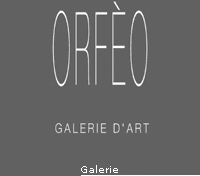|

BIOGRAPHICAL NOTES ABOUT ANDREA GABBRIELLINI
Andrea Gabbriellini (Pisa, Italy, 1933) is a painter who is
known for his eclecticism which has led him to make avant-garde
artistic operations, experimented through a spontaneous sensuality
and a restless conceptual research. His career develops from
an initial figurative period to the most extreme consequences
of an an-iconic approach.
The artist bases his applications upon various systems of
elements which form expressive structures, temporally variable,
giving rise to a story and a title for the various seasons
that he calls “cycles”: Solitudini, Giardini,
Simboli, Andromeda, Pagine, Incantesimi, Spazi necessari,
Barriere, Frantumazioni etc. (Solitudes, Gardens, Symbols,
Andromeda, Pages, Necessary spaces, Barriers, Shatterings
etc.).
Gabbriellini has had over 40 personal exibitions in various
places in the world, among which: Florence 1965, 1967, 1990,
2004 – New York, 1968 – Venice, 1971- Paris, 1975
and 1997 – Pisa, 1969, 1974, 1986, 1991 – Salzburg,
1995 – Los Angeles, 1996 – Luxembourg, 1994, 1998,
2001 – Bologna, 1998, 1999 and Milan, 2004.
He has taken part in numerous national and international displays
and has obtained prizes and prestigious acknowledgements in
many of them. Among these the INPS Prize at the Palazzo della
Quadriennale, Roma, 1963 – The national Prize “del
Fiorino”, Palazzo Strozzi, Florence, 1965 – The
Exibition of Italian Art at The Art Space, New York, 1965
– The Biennial of Engraving and Original Drawing at
Palazzo della Ragione, Padova, 1966 – The Panorama of
Contemporary Graphics at the Puskin Museum, Moscow, 1972 –
The 5th International Biennial at Reales Atarazanas, Barcelona,
1975 – The Bidart, Bergamo 1989, 1990, 1991, 1994 –
The Siac, Florence, 1989, 1990 – The Artefiera, Bologna,
1990, 1992, 1993, 1998, 1999, 2000 – The Arteroma, Palazzo
dei Congressi, Rome, 1990, 1991, 1992 – The Biennial
of Contemporary Art at Palazzo Nervi, Turin, 1990 . The Biennial
of International Art, Milan 1991 – Artexpo, New York
1995 – Lineart, Gent, 1996 – Art Cologne, 1998
– The International Exibition inaugurating the Museum
of Contemporary Art, Arezzo, 2003.
In 1991, 2003 and 2004 three public exibitions were dedicated
to him by Pisa Town Council at Palazzo Lanfranchi, Pisa, by
Pontedera Town Council at the Art Centre and by the Tuscan
Regional Council at Palazzo Panciatichi, Florence.
Among the numerous art critics who have taken interest in
his work are: Fortunato Bellonzi, Dino Carlesi, Enzo Carli,
Gillo Dorfles, Giovanni Faccenda, Francesco Filippi, Giorgio
Di Genova, Nicola Micieli, Tommaso Paloscia, Franco Russoli,
Luigi Servolini, J.P. Schneider, Vittorio Sgarbi e Mark Tibbet.
His name appears in many of the most important post-war bibliographic
works, encyclopaedias and documentaries.
His works are to be found in various Museums and Public Art
Collections around the world.
In the 90s the art historians Enzo Carli (Catalogo) and Tommaso
Paloscia (Accadde in Toscana) included Gabbriellini among
the most significant Tuscan visual artists of the last 30
years of the 20th century. In 2004 the critic Giovanni Faccenda,
director of the Museum of Modern and Contemporary Art in Arezzo
defined him as a protagonist of the present Italian artistic
season.
Gabbriellini lives and works in Via Napoli,4 – Pisa
(tel. and Fax: ++39-50-551781) and in his summer residence
in Lido di Camaiore (Lucca), Via Gioberti, 10 (tel. ++39-584-610185).
Reflection about my work
…I regret that I have occasionally found some difficulties
in anchoring my thoughts in the action space, which is still
a virtual space, the space for dreaming. In this space, which
thought itself creates, freed from elements which have been
refused, become EMPTY, become NOTHING, I find it easy to think
through images (sometimes connected to concepts and in other
moments – even better- detached from them) and to find
places of purity inhabited by presences which do not confront
one another. Presences which have the same colours of the
inhabited space, silent, pure, white, intact, red, blue, pink,
green, yellow – better still of the same colour , but
even two, three (apparently different but with the same destiny),
living inhabitants of the living space. In this way a miracle
occurs in the discovery of “something” to express,
“something” that is nearer to the truth, hidden
truth, jealous truth, for an eternal form of painting.







|
|







